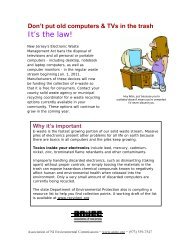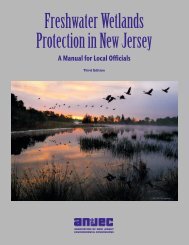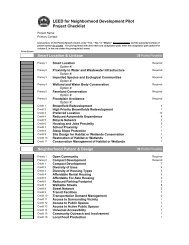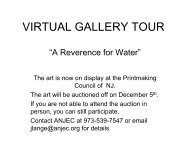New Jersey Statewide Stormwater Flood Hazard and Wetlands Programs
NJ Statewide Stormwater, Flood Hazard and Wetlands ... - ANJEC
NJ Statewide Stormwater, Flood Hazard and Wetlands ... - ANJEC
You also want an ePaper? Increase the reach of your titles
YUMPU automatically turns print PDFs into web optimized ePapers that Google loves.
<strong>New</strong> <strong>Jersey</strong> <strong>Statewide</strong><br />
<strong>Stormwater</strong>, <strong>Flood</strong> <strong>Hazard</strong><br />
<strong>and</strong> Wetl<strong>and</strong>s <strong>Programs</strong>
Authorities<br />
Federal Clean Water Act<br />
NJ Water Pollution Control Act<br />
NJ <strong>Stormwater</strong> Management Act<br />
Soil Erosion <strong>and</strong> Sediment Control Act<br />
Residential Site Improvement St<strong>and</strong>ards<br />
Act<br />
Water Quality Planning Act<br />
Freshwater Wetl<strong>and</strong>s Protection Act<br />
Water Quality Planning Act<br />
Coastal Area Facilities Review Act<br />
Dam Safety Act<br />
<strong>Flood</strong> <strong>Hazard</strong> Area Control Act<br />
Municipal L<strong>and</strong> Use Law<br />
Waterfront Development Act
DEP Units Involved<br />
Division of Water Quality<br />
Division of Watershed Management<br />
Water Compliance <strong>and</strong> Enforcement<br />
L<strong>and</strong> Use Compliance <strong>and</strong> Enforcement<br />
Division of L<strong>and</strong> Use Regulation<br />
Office of Communications<br />
Office of Legislature Affairs<br />
Water Monitoring <strong>and</strong> St<strong>and</strong>ards<br />
Division of Science, Research & Technology
External Agencies Involved<br />
Environmental Infrastructure Trust<br />
Department of Agriculture<br />
Department of Community Affairs<br />
Department of Transportation<br />
Meadowl<strong>and</strong>s Commission<br />
Pinel<strong>and</strong>s Commission<br />
D & R Canal Commission<br />
Municipal Planning Boards
Permitting<br />
NJPDES Industrial <strong>Stormwater</strong> Permits<br />
NJPDES Municipal <strong>Stormwater</strong> Permits<br />
NJPDES Construction Permits<br />
Wetl<strong>and</strong>s Permits<br />
Stream Encroachment Permits<br />
Coastal Permits
<strong>Stormwater</strong> Rules: NJPDES &<br />
<strong>Stormwater</strong> Management<br />
USEPA adopted NPDES rules in 1999<br />
to address municipal stormwater<br />
concerns.<br />
All delegated states <strong>and</strong> EPA Regions<br />
are implementing the program at<br />
same time.<br />
DEP promulgated two rules in 2004 –<br />
NJPDES <strong>Stormwater</strong> <strong>and</strong> <strong>Stormwater</strong><br />
Management Rule.<br />
DEP also issued four General Permits<br />
to regulate most of the State.
<strong>Stormwater</strong> Permits - Who<br />
Is Regulated?<br />
Existing Development (Ongoing basis<br />
through NJPDES)<br />
<br />
<br />
<br />
<br />
2,754 Industrial Facilities<br />
558 Municipalities<br />
73 County, State , Federal, <strong>and</strong> University<br />
Public Complexes<br />
33 State, Interstate, <strong>and</strong> County Highway<br />
Agencies<br />
<strong>New</strong> Development<br />
<br />
<br />
~ 2,000 NJPDES Construction Permits/Year<br />
~ 1000 L<strong>and</strong> Use Permits/Year
<strong>New</strong> Development –<br />
Regulatory Consistency<br />
NJPDES &<br />
<strong>Stormwater</strong><br />
Management<br />
Rules<br />
NJPDES<br />
Municipal<br />
<strong>Stormwater</strong><br />
Permits<br />
Residential<br />
Site<br />
Improvement<br />
St<strong>and</strong>ards<br />
(RSIS)<br />
NJDEP<br />
L<strong>and</strong><br />
Use<br />
Regulation<br />
Permits<br />
Municipal<br />
<strong>Stormwater</strong> Plans<br />
&<br />
Ordinances<br />
NJPDES<br />
Construction<br />
Permit/<br />
Soil<br />
Conservation<br />
Districts
<strong>New</strong> Development Requirements –<br />
Municipal, RSIS, L<strong>and</strong> Use, NJPDES<br />
Construction Permit<br />
<strong>Statewide</strong> requirements<br />
<br />
<br />
<br />
• Nonstructural SWM strategies<br />
• Groundwater Recharge<br />
• Quantity Control for <strong>Flood</strong>ing<br />
& Erosion<br />
• Quality Control<br />
Special Protection Measures for C1<br />
Construction controls for soil erosion <strong>and</strong> other concerns<br />
Municipal <strong>Stormwater</strong> Management Plans <strong>and</strong><br />
Ordinances
Existing Development<br />
Requirements<br />
Street sweeping<br />
<strong>New</strong> storm drain inlets <strong>and</strong> retrofits<br />
<strong>Stormwater</strong> facility maintenance<br />
De-icing material storage<br />
Maintenance yard operations – Fueling, good<br />
housekeeping <strong>and</strong> employee training<br />
Local Ordinances – Litter, Pet Waste, Waste Disposal,<br />
Yard Waste, Illicit Connections, Wildlife Feeding<br />
Road erosion control<br />
Outfall pipe stream scouring<br />
Illicit connection elimination<br />
Vehicle washing facilities
Education <strong>and</strong> Outreach<br />
NJDEP – “Clean Water NJ”<br />
Local public education<br />
Brochures<br />
Yearly education event<br />
DEP Outreach<br />
Presentations<br />
Mailings Website<br />
Commercials (videos)
<strong>Flood</strong> <strong>Hazard</strong> Rules<br />
<strong>Flood</strong> <strong>Hazard</strong> Area<br />
A flood hazard area exists along every regulated water that has a<br />
drainage area of 50 acres or more.<br />
The <strong>Flood</strong> <strong>Hazard</strong> Area is composed of the <strong>Flood</strong>way <strong>and</strong> the <strong>Flood</strong> Fringe.<br />
The <strong>Flood</strong>way is 0.2 ft above 100 Year <strong>Flood</strong> Zone.
Riparian Zone & SWRPA<br />
Measures 50, 150 or 300 ft from a regulated water.<br />
150 ft for Trout Production, Trout Maintenance, T& E Habitat, Acid Soils<br />
300 ft. Along a Category 1 Waterway <strong>and</strong> upstream tributaries within the<br />
same HUC-14 watershed.<br />
50 ft. for all other waters.<br />
SWRPA similar to Riparian Zone but only applies if project is major<br />
development <strong>and</strong> if on a USGS Quad or Soil Survey.
Regulated Activities in Riparian<br />
Zone<br />
The alteration of topography through excavation, grading <strong>and</strong>/or<br />
placement of fill;<br />
The clearing, cutting <strong>and</strong>/or removal of vegetation in a riparian<br />
zone;<br />
The creation of impervious surface;<br />
The storage of unsecured material;<br />
The construction, reconstruction <strong>and</strong>/or<br />
enlargement of a structure; <strong>and</strong><br />
The conversion of a building into a<br />
private residence or a public building.
Wetl<strong>and</strong>s Rules<br />
Identifying Wetl<strong>and</strong>s<br />
Three part parameter approach:<br />
Hydrology<br />
Vegetation<br />
Soils<br />
NJDEP’s Official Determination<br />
Of Regulated Areas<br />
Letters of Interpretation (LOI)<br />
Line Delineation<br />
Presence/Absence Letter<br />
Line Verification<br />
LOIs are valid for 5 years from the date of<br />
Issuance
Types of Wetl<strong>and</strong>s<br />
Ordinary<br />
Isolated wetl<strong>and</strong>s < 5,000 SF <strong>and</strong> more than 50% of the area within 50’ is disturbed<br />
Drainage ditches <strong>and</strong> swales<br />
<strong>Stormwater</strong> Basins<br />
No Transition Area is required<br />
Exceptional<br />
Presence or suitable habitat for Threatened<br />
or Endangered Species<br />
Hydrologically connected to Trout Production<br />
waters<br />
150’ Transition Area Required<br />
Intermediate<br />
Wetl<strong>and</strong>s that are neither Ordinary nor<br />
Exceptional<br />
50’ Transition Area Required
Wetl<strong>and</strong>s Regulated Activities<br />
Activities<br />
Removal/disturbance of soil<br />
Drainage/disturbance of the water level<br />
Erection of Structures<br />
Addition of pavement<br />
Disturbance of Vegetation<br />
Exemptions are allowed for some farm <strong>and</strong> forestry related activities<br />
Regulation<br />
General Permits (some of these include TAWs)<br />
Individual Permits (some of these include TAWs)<br />
Transition Area Waivers (TAW)<br />
If a project is a major development <strong>and</strong> requires a General or<br />
Individual Permit, it must meet the <strong>Stormwater</strong> Rule at N.J.A.C. 7:8
General <strong>and</strong> Individual Permits<br />
Approximately two dozen General Permits.<br />
General Permits have varying parameters for allowable<br />
disturbances.<br />
Disturbances which exceed the<br />
General Permit threshold require an<br />
Individual Permit.<br />
Permits are valid for 5 years from<br />
the date of issuance.
Where Can Development Go?
How Do Environmental<br />
Commissions Fit Into <strong>Stormwater</strong><br />
Reviews?<br />
Research, compile <strong>and</strong> direct studies, including environmental resource<br />
inventories, water studies, energy audits <strong>and</strong> conservation easement<br />
inventories;<br />
Review development proposals <strong>and</strong> promote long-range environmental<br />
planning based on the capacity of the l<strong>and</strong> <strong>and</strong> natural resources;<br />
Inventory, plan <strong>and</strong> preserve open space;<br />
Inform residents through educational programs, displays, publications<br />
<strong>and</strong> meetings;<br />
Work with neighboring commissions <strong>and</strong> other organizations to address<br />
regional <strong>and</strong> statewide environmental problems.<br />
*
What Can You Do?<br />
Underst<strong>and</strong> the site planning process<br />
<strong>and</strong> the identification of environmental<br />
issues.<br />
Underst<strong>and</strong> critical elements of<br />
stormwater management with regard to new <strong>and</strong> re-development.<br />
Underst<strong>and</strong> the basics of DEP regulation <strong>and</strong> permit process to guide<br />
planning <strong>and</strong> zoning board decisions.<br />
Review site plans with a “careful eye” towards these issues.<br />
Educate the community about stormwater, flooding <strong>and</strong> wetl<strong>and</strong>s<br />
protection.
Barry Chalofsky, P.P.<br />
Environmental <strong>and</strong> L<strong>and</strong> Use Planning<br />
29 Pine Knoll Drive<br />
Lawrenceville, NJ 08648<br />
For More Information go to www.bchalofassociates.com<br />
or call 609-883-8053












